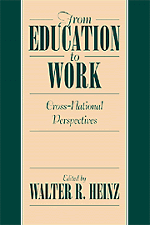Book contents
- Frontmatter
- Contents
- Contributing Authors
- Preface
- Introduction: Transitions to Employment in a Cross-National Perspective
- Part I Social Origin, Gender, and Transition Patterns
- 1 Social and Geographical Mobility 20 Years after High-School
- 2 Diverse Directions: Young Adults' Multiple Transitions
- 3 New Routes to Employment: Integration and Exclusion
- 4 From Education to Employment: Occupations and Careers in the Social Transformation of East Germany
- Part II Education and Labour Markets: Work Experiences, Skills, and Credentials
- Part III Changes in the Social Context of Transitions
- References
- Index
1 - Social and Geographical Mobility 20 Years after High-School
Published online by Cambridge University Press: 30 September 2009
- Frontmatter
- Contents
- Contributing Authors
- Preface
- Introduction: Transitions to Employment in a Cross-National Perspective
- Part I Social Origin, Gender, and Transition Patterns
- 1 Social and Geographical Mobility 20 Years after High-School
- 2 Diverse Directions: Young Adults' Multiple Transitions
- 3 New Routes to Employment: Integration and Exclusion
- 4 From Education to Employment: Occupations and Careers in the Social Transformation of East Germany
- Part II Education and Labour Markets: Work Experiences, Skills, and Credentials
- Part III Changes in the Social Context of Transitions
- References
- Index
Summary
Sociologists argue that all societies are stratified, meaning that social positions or roles are differentially structured in terms of access to power, wealth, and social status. Furthermore, there is a set of rules that governs who gains access to these different social positions (Matras, 1984). Speaking somewhat metaphorically, stratification manifests itself in a series of ladders or shifting positions that provide for social mobility within the existing but also changing social structure.
For individuals and groups, social mobility is problematic in at least three ways. First, one must compete for, find, and hold one's place in the stratification system. This aspect of stratification highlights life course and manifests itself most commonly as an occupational career. Second, as social structure changes, the ladders are altered and rearranged – some disappearing altogether – thus changing the bases for competition. This aspect invites comparison between the current generation and past ones and what is called intergenerational mobility. Finally, people also desire to help and provide for their own progeny and seek to make the process of social mobility more secure and predictable for them. This suggests that the process contains elements of risk when moving up or down or changing ladders of mobility. These risks can be minimized by drawing on family resources and building institutional forms favorable to mobility (e.g., accessible higher education) through political and community action (Matras, 1984, p. 8; Beck, 1992, p. 94; Heinz, 1991b, p. 11).
- Type
- Chapter
- Information
- From Education to WorkCross National Perspectives, pp. 25 - 45Publisher: Cambridge University PressPrint publication year: 1999
- 1
- Cited by



